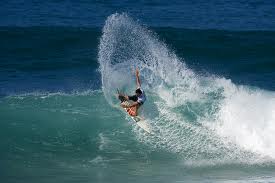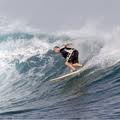
As we have discussed previously, all solid surfing maneuvers rely on the fundamentals of the basic direction change. Whether you are doing a vertical turn such as:
· a re–entry which requires you to change from your horizontal down the line position into a more straight up vert lip bash.
· Or a round house cut back where you would smoothly and constantly be changing in a figure or eight directions through a series of more subtle direction and position changes of your board.
None of these maneuvers can be done without a good understanding direction changing.
Like all maneuvers in sport, you won’t master the turn without plenty of practice that means you must be prepared to put in the time, know you will be falling a lot but eventually it will pay off and you will feel that sense of pride in mastering the task at hand.
Currently you can take off and ride a clean face (unbroken) wave heading straight down the line. Congratulations – you are reaching the next level!
So you want to start ”doing stuff” on the wave. Surfing can be compared to the math’s you do /once did in school- it happens in stages and if you don’t quite understand and master the current task you are on the steps that follow will be so much harder to get through. Don’t try and rush ahead. Master the task at hand.
Changing direction is as simple as understanding yourself and your capabilities. It is about leaning and getting your board on the rail (your rails are on either side of your board) and leaning into the new direction you want to be going. Tap into your intuition and feel it through. Start leaning (on the rail) in the direction you want to go. If you find you are leaning too much you will automatically topple over. If you are not leaning enough you will not change direction.
Keep in mind each part of your body is playing an important role the process.
· your eyes – need to be looking in the direction you want to travel in,
· your shoulders are starting to turn and moving in that same direction as your eyes are looking,
· your torso ( waist ) will automatically start twisting to turn in the new direction too ,
· Your knees are bent and acting as shock absorbers to help with balance and control.
· Your feet are planted firmly on your board and your toes are helping you with balance
· Your leading arm (one in front) will be guiding you in the direction you are intending on traveling in
· And your trailing arm (back arm) is sufficiently raised for balance when you are leaning on the rail.
Hope this helps! 

You must be logged in to post a comment.